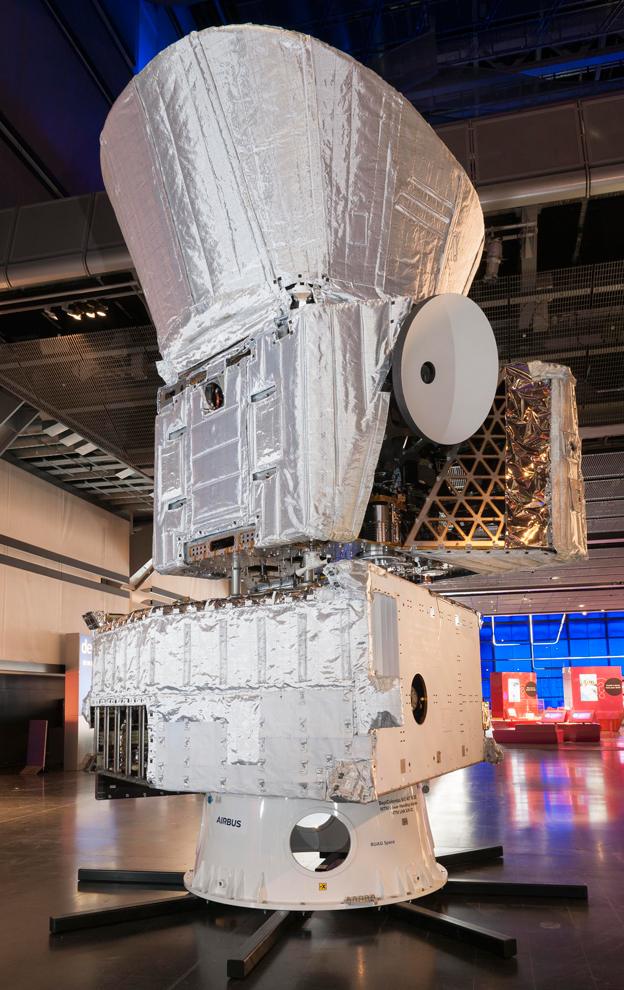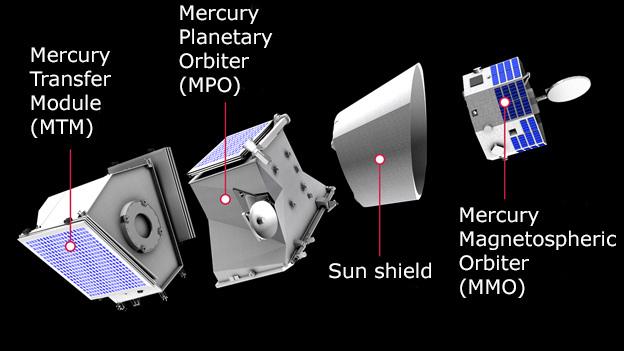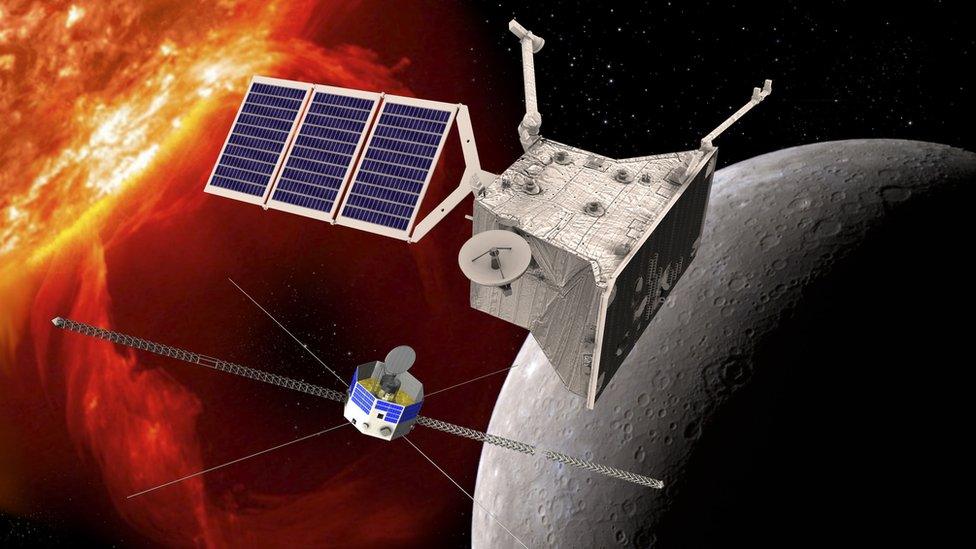Copy of BepiColombo Mercury mission goes on display
- Published

The BepiColombo Structural Thermal Model will become the centrepiece for events that will be held at the museum to mark key milestones in the progress of the European mission to Mercury
A near-exact replica of the probe Europe will be sending to Mercury later this year has gone on show at London's Science Museum, external.
BepiColombo, external is due to blast off on a seven-year journey to the inner-most world on an Ariane rocket in October.
Referred to as the Structural Thermal Model (STM), the object now on display in the Wellcome Wing was used to prove the fundamental design of the mission.
Its different stacked parts stand over 6m in height.
"If you leave aside the aeroplanes in our collection, this is one of the biggest objects we've ever had - certainly, one of the chunkiest," said Doug Millard, the Science Museum's space curator.

How to build a mission to Mercury

Europe's Airbus company led production of the MTM, MPO and the sun shield for MMO
The BepiColombo mission comprises three major parts
MTM is a propulsion unit to control the cruise to Mercury
Europe's Mercury Planetary Orbiter carries 11 instruments
For the cruise, a sun shield protects Japan's MMO spacecraft
At Mercury, Japan's orbiter dispenses with this shield
MMO and MPO will go into different polar orbits at Mercury

Bepi is really three spacecraft in one. It actually contains two different probes - one built in Europe, the other in Japan - that will separate once the mission arrives at its destination.
But the pair travel together from Earth, sitting atop a big propulsion module.
This unit has the vital job of managing the long cruise to Mercury.
Four ion engines will brake Bepi's fall into the deep gravity well of the Sun.
"You could get to Mercury very quickly if you just careened down hill on your go-kart; you could get there in roughly three months," explained Prof Mark McCaughrean, the European Space Agency's senior science advisor.
"The problem with that is that you would pick up so much speed, you couldn't stop. So what we have to do with BepiColombo is take a much more circuitous route; kind of the slow way down the hill instead of straight over the edge."
Mark McCaughrean: BepiColombo takes science at Mercury to the next level
Along with the ion-engine braking, the gentle path to Mercury also involves doing a number of flybys of the planets, using the tug of their gravity to sap the probe's speed.
Assuming this all works, Bepi should arrive in orbit at the little planet, ready to begin its science, in 2025.
The expectation, of course, is that everything will work out just fine. And that confidence is borne, in large part, from all the hard work that was done on the STM.
A Structural Thermal Model is assembled ahead of the "real thing".
It is where you identify any mistakes or weaknesses in the design.
"The STM is where you learn all your lessons, and any problems you encounter - you solve them on this model so that the flight model build goes really smoothly," said Jess Marshall from Airbus, which led the industrial consortium that has produced Bepi.
"For me as a systems engineer - it's my job to make sure it is all going to work together, so the STM is such a key piece in that process."
Mercury explainers
An STM is fabricated using the same materials as the eventual flight model, right down to its screws and glues.
It will also contain representative electronics and even boxes to mimic a probe's science instruments.
The whole structure gets shaked and baked, and assaulted with sound, to simulate the conditions of launch and of operation in space.
One of the major challenges for Bepi is heat and how to handle it.
The real spacecraft will be toasted on one side by the Sun and on the other by the radiant heat coming up from the "hot potato" planet, where surface temperatures are high enough to melt some metals. Testing on the STM has shown the flight model will cope.
Visitors to the Science Museum will get to see some of Bepi's heat-resistant strategies, such as its white insulation blankets.
The STM is set to become the focus of an education campaign, Mr Millard said.
"We have a very active team of explainers who will mingle with the public, and, certainly, when the big milestones come up, such as the launch and the flybys, we'll have events here alongside one of the authentic parts of the mission."
The real BepiColombo is currently in French Guiana where it is being prepared for its Ariane launch at the country's spaceport.

Mercury: An oddball close to the Sun
Jess Marshall: "We use the STM to prove our flight model will work"
Past Mercury visitors were Nasa missions: Mariner 10 and Messenger
The planet's diameter is 4,880km - about one-third that of the Earth
It is the second densest planet in the Solar System: 5.4 grams/cu cm
The Caloris Basin is the largest surface feature (1,550km across)
It is an extreme place: surface temps swing between 425C and -180C
There is water-ice in the planet's permanently shadowed craters
Mercury's huge iron core takes up more than 60% of the planet's mass
Apart from Earth, it is the only inner planet with a global magnetic field

Jonathan.Amos-INTERNET@bbc.co.uk, external and follow me on Twitter: @BBCAmos, external
- Published6 July 2017
